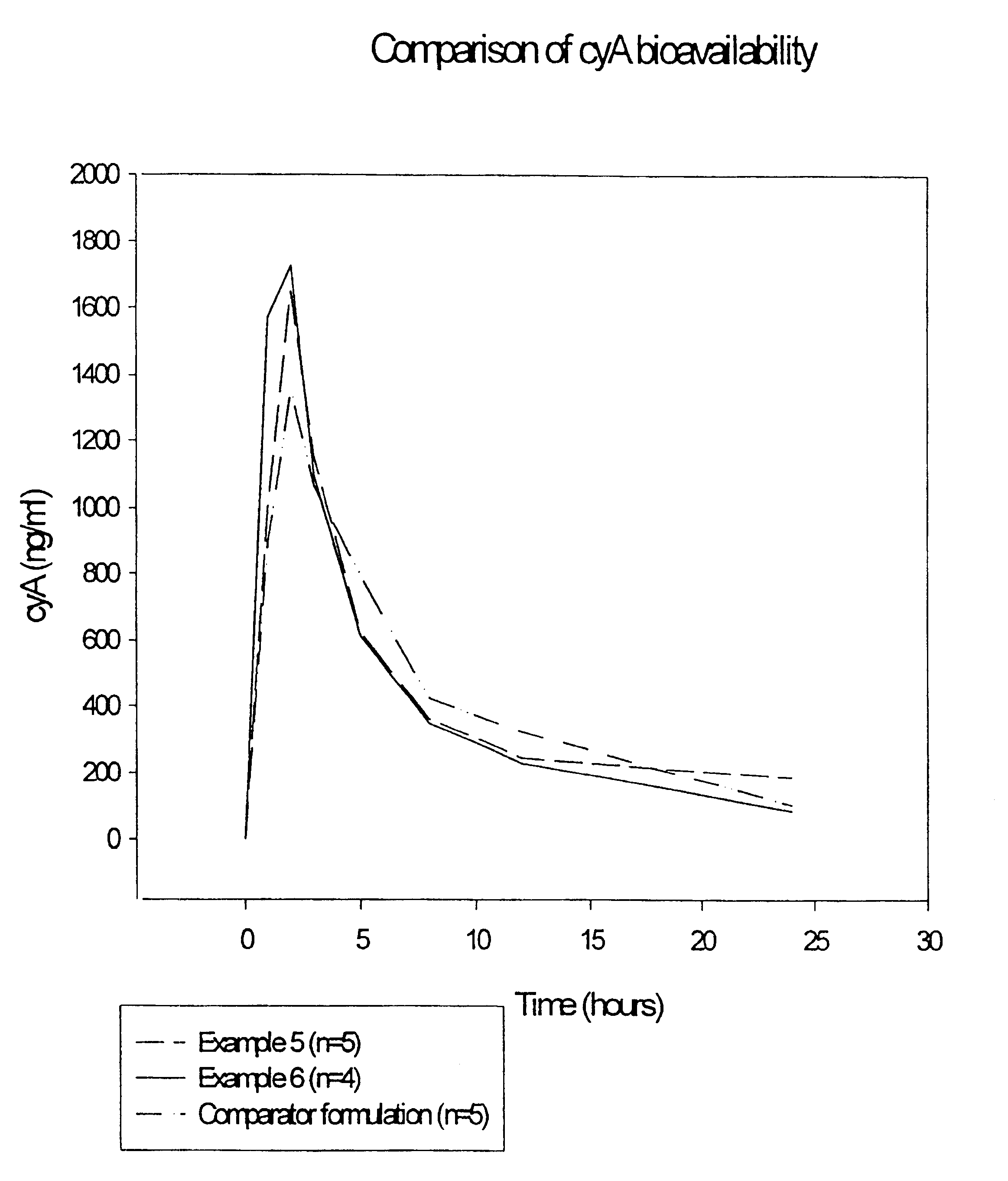Pharmaceutical compositions and their use
a technology of compositions and pharmaceuticals, applied in the field of pharmaceutical compositions, can solve the problems of marked decrease of aqueous solubility and hence drug concentration at membrane surfaces, lack of efficacy, and lowered uptake and bioavailability, so as to improve the bioavailability and consistency of absorption of either lipophilic and non-lipophilic effects
- Summary
- Abstract
- Description
- Claims
- Application Information
AI Technical Summary
Benefits of technology
Problems solved by technology
Method used
Image
Examples
example 1
18 parts of analytically pure soya PC, 27 parts of analytically pure MAPC, and 10 parts of cyclosporin A (cyA) were dispersed in 22.5 parts of ethanol. To this slurry 22.5 parts of glycerol was added. A flowable, optically clear solution resulted after equilibrating the mixture for 24 hours.
0.200 g of the above composition was dispersed in 10 ml of filtered deionised water at room temperature and yielded EML aggregates below 100 nm Z average diameter measured in a Malvern Autosizer. 10 g of this aqueous dispersion was analytically filtered through a pre-weighed 200 nm polycarbonate filter as described above. The percentage of unassociated cyA was found to be less than 1% by weight.
example 2
The fractionated EML blend used in this example was obtained from soya and had a PC:MAPC weight ratio of approximately 60:40. 45 parts of EML and 5 parts parts of cyA were dispersed in 12.5 parts of ethanol in a glass container. To this slurry 18.75 parts of propylene glycol and 18.75 parts of glycerol were added and equilibrated for 48 hours at room temperature to generate a homogenous liquid composition.
0.8 g of the liquid composition was dispersed in 19.2 g of deionised water. A 10 g aliquot of the resultant turbid dispersion containing EML aggregates was analytically filtered through a pre-weighed 200 nm polycarbonate filter. The percentage of unassociated cyA was determined gravimetrically and was found to be less than 0.5% by weight. No precipitation was evident when this filter was examined under the light microscope at a magnification of .times.100. The EML aggregates had a Z average diameter about 390 nm using a Malvern Autosizer.
example 3
18 parts of purified soya PC, 27 parts of purified soya MAPC and 10 parts of cyA were dispersed in 11.25 parts of ethanol in a closed vessel. To this slurry, 22.5 parts of propylene glycol and 11.25 parts of glycerol were added. After equilibrating the mixture for 24 hours an optically clear solution was produced.
0.200 g of this fluid composition was dispersed in 10 ml of deionised water. This slightly turbid dispersion of EML aggregates was analytically filtered through a pre-weighed 200 nm polycarbonate filter. After air drying this filter, the filter was re-weighed and examined under a light microscope. The percentage of unassociated cyA was found to be less than 1% by weight. No precipitation was observed when the filter was examined under the light microscope at a magnification of .times.100.
PUM
| Property | Measurement | Unit |
|---|---|---|
| Fraction | aaaaa | aaaaa |
| Percent by mass | aaaaa | aaaaa |
| Percent by mass | aaaaa | aaaaa |
Abstract
Description
Claims
Application Information
 Login to View More
Login to View More - R&D
- Intellectual Property
- Life Sciences
- Materials
- Tech Scout
- Unparalleled Data Quality
- Higher Quality Content
- 60% Fewer Hallucinations
Browse by: Latest US Patents, China's latest patents, Technical Efficacy Thesaurus, Application Domain, Technology Topic, Popular Technical Reports.
© 2025 PatSnap. All rights reserved.Legal|Privacy policy|Modern Slavery Act Transparency Statement|Sitemap|About US| Contact US: help@patsnap.com


